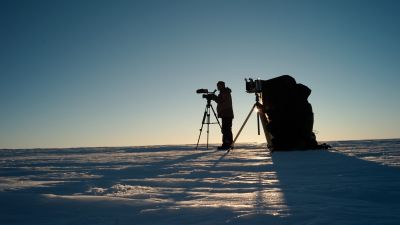
NIPR Geologists Reach Base Camp
With high spirits despite the hard work, the team has guided the geologists from the National Institute of Polar Research to their base camp at Austkampane, where they will stay until early January to survey the surrounding mountains and study the rocks.
-
Kristof Soete prepares the CTD to be used at the coast in a few days.
© International Polar Foundation / Alain Hubert
-
Kristof preparing an adapter for the generator in the workshop.
© International Polar Foundation / Alain Hubert
-
A bit of relaxation while preparing the sledges for the field research.
© International Polar Foundation / Alain Hubert
-
Paul Herman fixing the protection cover of the winch that will allow for measures several hundreds of meters deep.
© International Polar Foundation / Alain Hubert
-
A more detailed view of the winch.
© International Polar Foundation / Alain Hubert
-
When the weather permits it, the preparation work is done outside.
© International Polar Foundation / Alain Hubert
-
The five Japanese each pull two sledges on their way to the field camp at Austkampane, 76km east of the station.
© International Polar Foundation / Alain Hubert
-
The PEA team guiding the Japanese geologists through the white-out
© International Polar Foundation / Alain Hubert
-
Arrival at base camp: the Japanese will stay there until the beginning of January
© International Polar Foundation / Alain Hubert
-
The team immediately installs the mess tent while the wind picks up speed.
© International Polar Foundation / Alain Hubert
-
A nice windscoop on the way back to PEA: these features are carved by the strong winds of Antarctica.
© International Polar Foundation / Alain Hubert
-
Unloading of the fuel for the geologists: they will be using the ski-doos to survey the mountains and do the research to approach the rocks.
© International Polar Foundation / Alain Hubert
-
At the base, the team still clears the snow after the hefty storm of last week.
© International Polar Foundation / Alain Hubert
-
On top of the garages, the work never ends. The solar panels will be moved to prevent such snow accumulation to occur in the future.
© International Polar Foundation / Alain Hubert
-
Just to give you an idea of the snow accumulation that returned in less than 30h, after we had cleared everything!
© International Polar Foundation / Alain Hubert
-
The snow clearing activities at the beginning of the season, two weeks ago.
© International Polar Foundation / Alain Hubert
-
A first hole in the snow wall blocking up the access to the garages.
© International Polar Foundation / Alain Hubert
-
How could we do it without this old bulldozer from a former Japanese station 60km away. It spent 32 years outside in Antarctica, both summer and winter.
© International Polar Foundation / Alain Hubert
-
Clearing the snow again, there's always something to do, but when the weather’s nice, it’s almost a pleasure. It’s not that warm however: -15°C, but working keeps us warm.
© International Polar Foundation / Alain Hubert
-
The Japanese bulldozer at work again.
© International Polar Foundation / Alain Hubert
-
The Prinoth tractors are essential: they already totaled more than 3,000 hours of work.
© International Polar Foundation / Alain Hubert
-
After work at 1am, we still have to eat, but enjoy a game of foosball first. Our cook is the only supporter: she arrived on November 26th, 4 days late.
© International Polar Foundation / Alain Hubert
-
On November 23rd, we celebrated Erik's birthday, he is our expedition engineer.
© International Polar Foundation / Alain Hubert
-
We had to wait for more than a week for the wind to settle and put out our flags: more than ever, the station is now international.
© International Polar Foundation / Alain Hubert
-
Coffee break away from the wind for these men who work up to 10 or 14 hours a day.
© International Polar Foundation / Alain Hubert
-
Paul just never gets tired! Here, he is clearing the snow near the snow melter.
© International Polar Foundation / Alain Hubert
-
Katie Leonard, an American scientist, just arrived. On December 1st, we will take her into the field for two weeks to work on sea ice.
© International Polar Foundation / Alain Hubert



























